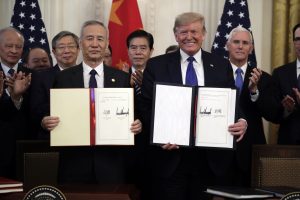The “Phase One” U.S.-China trade deal was officially inked on Wednesday, in a ceremony featuring U.S. President Donald Trump and Chinese Vice Premier Liu He. A White House press release touted the deal as a “historic agreement” that “will begin to rebalance our vital trade partnership with China” and “will be an incredible boost for American businesses, farmers, manufacturers, and innovators.”
Trump used similarly grandiose language in the ceremony, saying that the agreement “mark[s] a sea change in international trade.”
China watchers noted the extreme oddity of having a signing ceremony featuring a president on one side and an envoy on the other – something analysts agreed China’s president would never submit to. Jorge Guajardo, formerly the Mexican ambassador to China and currently a senior director with McLarty Associates, tweeted: “China would never host a signing ceremony between Xi and a non-head of state/government.” But the discrepancy in rank didn’t seem to bother Trump, who appeared jubilant at the signing.
The full text of the deal has not been released, but the White House claims that “China has agreed to make significant structural reforms in a wide range of critical areas.” Some of the promises may or may not actually be new, however; China has a long history of not living up to its past commitments. For example, the White House statement announced that “China will address numerous longstanding intellectual property concerns in the areas of trade secrets, trademarks, enforcement against pirated and counterfeit goods, and more.” Such promises have been happening since at least the Clinton administration. While China has made clear progress on IP issues, U.S. grievances have yet to be fully addressed.
One definitively new aspect of the deal is the pledge by China to “increase imports of American goods and services by at least $200 billion” over the next two years, including purchasing “between $40 and $50 billion in American agricultural goods each year for two years.” In the past, China’s record-high of U.S. agricultural imports in a single year stood at $26 billion.
In contrast to the White House’s fact sheet, the Chinese side has not confirmed a specific dollar target for increasing U.S. exports. Previously Chinese officials had insisted that market conditions would dictate what and how much China purchases from the United States. But given Trump’s obsession with the trade deficit specifically, it seems promising massive purchases was the easiest way to lower trade tensions – in effect, China bought its way into a trade truce.
In return, the United States dropped a threat to implement additional tariffs on $160 billion in Chinese imports and cut existing tariffs on $110 billion in Chinese goods from 15 percent to 7.5 percent.
The deal, as the “Phase One” moniker suggests, leaves much unfinished business. For starters, the United States still keeps the bulk of its tariffs intact – leverage intended to help with the as-yet hypothetical “Phase Two” negotiations. In effect, both sides have kicked the can down the road, picking some low-hanging fruit while leaving unaddressed fundamental questions that strike at the heart of China’s economic model: the role of government subsidies and state-owned firms, for example, and China’s determination to move up the technology value chain by any means necessary.
“It’s a strong first step,” Jeremie Waterman, the U.S. Chamber of Commerce’s vice president for Greater China, told The Associated Press. “It begins the process of addressing some of the structural concerns, but there’s a lot of work left to do. The meat, the core of [U.S. complaints about China’s aggressive tech policies] has not yet been addressed.”
U.S. Trade Representative Robert Lighthizer said that any further negotiations would depend on how the Phase One deal is put into practice. “We have to make sure this is implemented properly,” Lighthizer said. “This is the first agreement like this of its kind and we have to make sure that it works.”
The Associated Press contributed reporting.

No comments:
Post a Comment